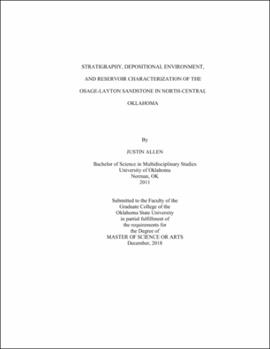| dc.contributor.advisor | Puckette, Jim | |
| dc.contributor.author | Allen, Justin | |
| dc.date.accessioned | 2021-10-21T15:52:06Z | |
| dc.date.available | 2021-10-21T15:52:06Z | |
| dc.date.issued | 2018-12 | |
| dc.identifier.uri | https://hdl.handle.net/11244/331150 | |
| dc.description.abstract | The Osage-Layton sandstone is an important oil- and gas-producing reservoir in Oklahoma. Previous studies have concluded that the Osage-Layton sandstone (also known as the Cottage Grove sandstone in central and northwest Oklahoma), was deposited in a fluvial deltaic setting that was sourced from the Ouachita Mountain region of southeastern Oklahoma. Little is known about the sandstone on a localized scale. The purpose of this study was to develop a better understanding of the distribution and depositional environment of the Osage-Layton sandstone from a regional scale and relate it to reservoir characterization of the sandstone on a localized scale. A combination of regional cross-sections, structure, and thickness maps were used to evaluate regional and local structure, depositional environments and sandstone distribution. It was concluded that the general paleo dip at the time of deposition of the Osage-Layton sandstone was north-north westward. Paleo shorelines that trend in a southwest to northeast direction were interpreted from distribution of delta front deposits and localized limestone banks. Core facies from eight wells were described and used to interpret Osage-Layton sandstone depositional environments. Cores from the Garrity #10-24 and Hart #4-24 wells were sampled for thin-section petrography to determine constituents, porosity types, and reservoir quality. The lower Osage-Layton sandstone is interpreted to be a series of stacked channels with thin intervals of flooding and tidal reworking. Between the upper and lower Osage-Layton sandstones is a middle section that is interpreted to be a zone of tidal flat deposits. The upper Osage-Layton sandstone appears to be mostly tidal deposits. Based on these findings, it is concluded that the Osage-Layton sandstone was deposited initially in a deltaic setting that was influenced by both fluvial and tidal processes. Tidal processes dominated upper Osage Layton deposition. In order to fully understand the Osage-Layton sandstone at the field scale, it is necessary to integrate depositional features, constituents, porosity, and reservoir data from core with sandstone distribution patterns, interval thicknesses, and wireline log and core-derived electrofacies to construct a reasonable reservoir model. | |
| dc.format | application/pdf | |
| dc.language | en_US | |
| dc.rights | Copyright is held by the author who has granted the Oklahoma State University Library the non-exclusive right to share this material in its institutional repository. Contact Digital Library Services at lib-dls@okstate.edu or 405-744-9161 for the permission policy on the use, reproduction or distribution of this material. | |
| dc.title | Stratigraphy, depositional environment, and reservoir characterization of the Osage-Layton sandstone in north-central Oklahoma | |
| dc.contributor.committeeMember | Hileman, Mary | |
| dc.contributor.committeeMember | Pashin, Jack C. | |
| osu.filename | Allen_okstate_0664M_16079.pdf | |
| osu.accesstype | Open Access | |
| dc.type.genre | Thesis | |
| dc.type.material | Text | |
| dc.subject.keywords | cottage grove | |
| dc.subject.keywords | missourian | |
| dc.subject.keywords | north-central oklahoma | |
| dc.subject.keywords | osage-layton | |
| dc.subject.keywords | sandstone | |
| thesis.degree.discipline | Geology | |
| thesis.degree.grantor | Oklahoma State University | |
